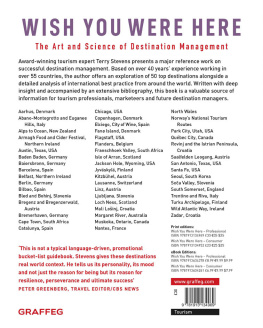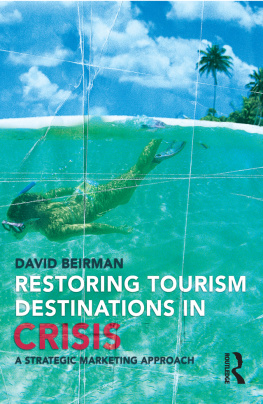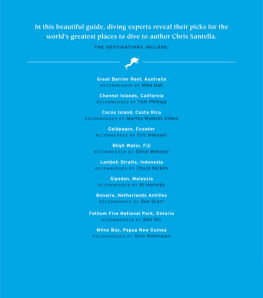All rights reserved.
The author and publisher have provided this e-book to you for your personal use only. You may not make this e-book publicly available in any way. Copyright infringement is against the law. If you believe the copy of this e-book you are reading infringes on the author's copyright, please notify the publisher at: https://us.macmillan.com/piracy
Galapagos Islands, Ecuador

Rare marine life and large species in big numbers
Located 560 miles off the west coast of Ecuador, the isolated volcanic cluster of the Galapagos Islands offers an abundance of unique biodiversity, quite unlike anywhere else in the world. Both above and below the waves, nature enthusiasts will spot rare endemic species such as the marine iguanas, while divers can marvel at the wide variety of large pelagics that pass through the islands waters in huge numbers. Its no surprise the island chain National Park and its surrounding Marine Reserve have been designated a UNESCO World Heritage Site.

There are two dive areas in the Galapagos that really stand out for us as first-class. Firstly, around Wolf and Darwin Islands you can dive with the world-famous schools of scalloped hammerheads, alongside Galapagos and silky sharks, turtles, mantas, and regular appearances from whale sharks. In contrast, at Punta Vicente Roca, arguably the best cold-water dive site in the world, watch the mysterious Mola mola visiting cleaning stations amongst a huge variety of smaller fauna such as the red-lipped batfish, frogfishes, barracuda, seahorses, and large schools of salemas, which offer wonderful opportunities for underwater photographers.

The Galapagos Islands provide a once-in-a-lifetime opportunity to experience and photograph species found nowhere else.

Practical info
Diving Season: Diving is year-round, however, the season is split between the warmer manta season (December - May) and cooler whale shark season (June - November).
Skill Level: Diving the Galapagos is for advanced divers and those with a tolerance for cold water (a 5 or 7mm wetsuit is essential). There are often currents, down-currents, thermoclines, and choppy surface conditions, and negative descents are commonplace.
Water Temperature: Warm Season 70-86F (21-30C), Cold Season 60-75F (16-24C).
Getting There: Fly internationally to Ecuadors Mariscal Sucre International Airport (UIO) in Quito or Jos Joaqun de Olmedo International Airport (GYE) in Guayaquil. Transfer from Guayaquil on to San Cristobal (SCY) or Isla Baltra (GPS) where most liveaboards depart.
Where to Stay: Due to the remoteness of many of the dive sites, visiting on a liveaboard is definitely the best option. Trips are normally 8 days, 7 nights, and the best way to reach all the top spots, however, there are some special 11 day/10 night trips for those wanting to spend extra days at Wolf and Darwin Islands.
Non-Diving Activities: Most liveaboards will include at least one land-based excursion with a licensed Galapagos naturalist. Expect to see giant tortoises, land iguanas, and a variety of seabirds such as the famous blue-footed boobies, great frigatebird, and flightless cormorants. Wildlife is as fascinating on land as it is underwater.
Jardines De La Reina, Cuba


Pristine reef diving teeming with life
Cubas Jardines de la Reina (Garden of the Queens) Marine Park is home to the largest and best-preserved coral reef system in the Caribbean. Nearly 850 sq. miles of protected waters are home to an awesome array of shark species, including silky, Caribbean reef, great hammerhead, lemon, nurse, and blacktip. Furthermore, divers are spoiled by an abundance of reef fish and over 50 species of coral and 200 species of sponge; an overwhelming plethora of life unlike anywhere else in the Caribbean. The island is also one of the few places where divers can safely get up close and personal with the American saltwater crocodile.
Jardines de la Reina offers divers the opportunity to experience a beautifully unspoiled reef paradise comparable with the rest of the Caribbean 50 years ago. Coupled with year-round warm water, consistently good visibility, and great weather, this area boasts not only the best diving in the Caribbean but some of the best scuba diving in the world.
Practical info
Diving Season: Year-round with temperatures ranging from 73-77F (23-25C), up to 83F (28C) in the height of summer.
Skill Level: All levels, theres something for everyone.
Water Temperature: 72-84F (22-29C).
Getting There: Fly to Havanas Jose Marti International Airport (HAV), or to Ignacio Agramonte International Airport (CMW), Camaguey.
Where to Stay: The Jardines de la Reina can only be visited by liveaboard, with a maximum of 900 guests permitted per year. However, a permanently moored floating hotel provides stable accommodation as an alternative.
Non-Diving Activities: Cuba has a wealth of top-side activities including great beaches, shopping, plenty of watersports, outdoor activities such as hiking, horse riding, and birdwatching, and a lively after-dark scene in the historic city of Havana. Most liveaboards trips will also include a shore excursion to visit an endemic species of rodent called the hutia. These mini capybara lookalikes will come directly to visitors looking for a handout of fresh papayas and bottled water.
NOTE: Due to current US government-imposed sanctions on Cuba, we are unable to take new reservations. Please contact us for more information or to get you booked on a trip to a similar destination.
Mainland Mexico


Easy access to exhilarating marine life encounters
Vibrant and exciting, Mexico has so much to offer as a dive destination that several locations are worthy of inclusion on our list of best scuba diving in the world. On the east coast, the Yucatan Peninsula offers divers easy access to the second-largest barrier reef in the world, and a plethora of marine life that makes its home there. Between June and September, the waters around Isla Mujeres, just off Cancun, host record-breaking numbers of whale sharks, and snorkeling alongside so many of these gentle giants is a thrilling encounter thats hard to beat.
















